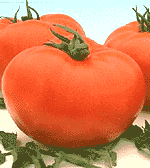世界上最受歡迎的水果
[ 2007-04-04 13:47 ]
世界上最受歡迎的水果是什么?猜不出來吧,是番茄!你一定納悶:番茄不是一種蔬菜嗎?錯了,錯了。到底是怎么回事呢?就讓下文為你一一道來吧。
 The tomato is the world's most popular fruit. And yes, just like the
brinjal and the pumpkin, botanically speaking
it is a fruit, not a vegetable. More than 60 million tons of tomatoes are
produced per year, 16 million tons more than the second most popular fruit, the
banana. Apples are the third most popular (36 million tons), then oranges (34
million tons) and watermelons (22 million tons). The tomato is the world's most popular fruit. And yes, just like the
brinjal and the pumpkin, botanically speaking
it is a fruit, not a vegetable. More than 60 million tons of tomatoes are
produced per year, 16 million tons more than the second most popular fruit, the
banana. Apples are the third most popular (36 million tons), then oranges (34
million tons) and watermelons (22 million tons).
Tomatoes were first cultivated in 700 AD by Aztecs and Incas.
Explorers returning from Mexico introduced the tomato into Europe, where it was
first mentioned in 1556. The French called it "the apple of love," the Germans
"the apple of paradise."
Tomatoes are rich in vitamins A and C and fibre, and are cholesterol free. An average size tomato (148 gram, or
5 oz) boasts only 35 calories. Furthermore, new medical research suggests that
the consumption of lycopene - the stuff that makes tomatoes red - may prevent cancer.
Lycopene is part of the family of pigments called carotenoids, which are natural compounds that create
the colours of fruits and vegetables. For example, beta
carotene is the orange pigment in carrots. As with essential amino
acids, they are not produced by the human body. Lycopene is the most
powerful antioxidant in the carotenoid family and, with
vitamins C and E, protect us from the free radicals that degrade many parts of
the body.
The scientific term for the common tomato is lycopersicon lycopersicum, which
mean "wolf peach." It is a cousin of the eggplant, red pepper, ground cherry,
potato, and the highly toxic belladonna, also
known as the nightshade or solanaccae. There
are more than 10,000 varieties of tomatoes.
Tomatoes are used in many food product, including, of course, tomato sauce
(ketchup), pasta and pizza. According to a
Steel Packing Council survey of 1997, 68% of chefs use canned tomatoes for
convenience, quality and flavouring.
botanically: 植物學的
Aztecs: 阿芝臺克人
Incas: 印加人
fibre: 纖維素
cholesterol: 膽固醇
lycopene: 番茄紅素
carotenoids: 類胡蘿卜素
beta
carotene: β胡蘿卜素
belladonna: 顛茄
nightshade, solanaccae:茄屬類植物
pasta: 意大利面
(英語點津 Annabel 編輯) |